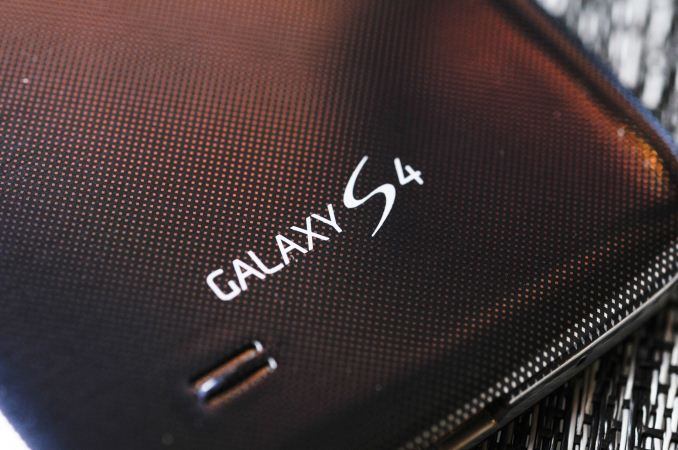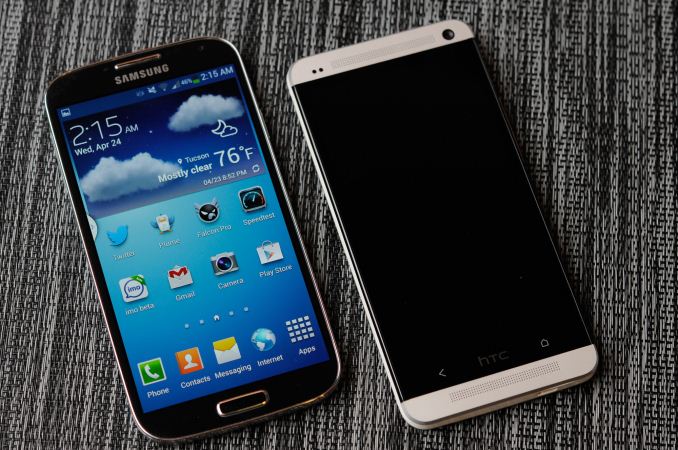Samsung Galaxy S 4 Review - Part 1
by Brian Klug on April 24, 2013 12:01 AM ESTFinal Words
Samsung has done a tremendous job creating a global following not only for its brand, but also for its software. In studying Samsung and its devices it becomes quite clear that although many enthusiasts yearn for pure, unadulterated Android, there are seemingly big pockets of the market who have grown used to (and maybe even desire?) Samsung's TouchWiz user experience. It really is a very clever strategy on Samsung's part. If you deliver products that your users appreciate, and deliver a uniquely different user interface at the same time, you begin to create an appreciation for that user interface as well. All of this flies in the face of what we as reviewers normally seem to prefer, but Samsung's success is proof of the fact that not everyone absolutely detests OEM customized Android.
Samsung's existing user base is likely the easiest to talk to about the Galaxy S 4. Compared to any previous Galaxy S device, the SGS4 is a clear step forward in all of the right areas. The display is higher resolution, the SoC is significantly faster, there's better WiFi (and connectivity depending on what generation of Galaxy S you're talking about) and obviously the Galaxy S 4 runs the absolute latest version of Android. Even on the camera side, Samsung has improved imaging performance over the Galaxy S 3 this generation thanks to its use of a wider aperture lens system. If you're a happy owner of a Samsung Galaxy S/S2/S3, you'll likely be a happy owner of a Galaxy S 4.
It's when you compare the Galaxy S 4 to its chief technical competitor, the HTC One, that the discussion becomes more complicated. HTC and Samsung take very different approaches to nearly every aspect of their flagship smartphones. Whether it's display (LCD vs. Super AMOLED), camera (low light vs. well lit performance), or software (subtle Sense 5 or feature filled TouchWiz), you couldn't pick two more different players in the Android space. So which is better?
It really depends on what you value more. The One's camera delivers better low light performance, while the Galaxy S 4's camera delivers better performance in well lit (e.g. outdoor) scenarios. The One's software customizations are definitely more subtle and out of your way, while Samsung's approach is much more feature overload and in your face. It's difficult to say for sure given our Sprint review unit, but HTC likely gets the slight edge in battery life based on our results here today (although these two devices can be close competitors depending on the workload). Samsung does integrate the faster SoC, despite both the Galaxy S 4 and HTC One shipping the same Snapdragon 600 platform. Samsung and HTC remain on opposite sides of the removable battery/microSD fence, if those two things matter to you then Samsung is the obvious choice. Finally there's a question of how much you value/desire an all-metal smartphone. For some, Samsung's choice in materials is going to continue to be a very big issue.
At the end of the day, the Galaxy S 4 is an evolution of the Galaxy S 3 in pretty much all of the areas you'd expect it to be. Whether or not that's what you wanted in a new Android smartphone is going to vary from one person to the next. The good news is that you at least have a choice.












335 Comments
View All Comments
CoryS - Friday, April 26, 2013 - link
Eh, I actually think phones are getting too thin. I put a case on my GS3 because I kept fumbling it due to how thin it was.nerdstalker - Wednesday, April 24, 2013 - link
What's with the QUALCOMM 4G sticker on the top bezel of the device? :sHaserath - Wednesday, April 24, 2013 - link
They're using a Qualcomm Snapdragon SOC with integrated LTE (4g)modem, I believe.nerdstalker - Wednesday, April 24, 2013 - link
Going the Intel way. :PBrian Klug - Wednesday, April 24, 2013 - link
There's been a Qualcomm 4G sticker on the top of Samsung phones since, hmm, T-Mobile SGS2 and AT&T SGS2 (Skyrocket). Even the Droid Charge/Galaxy Nexus VZW edition which had no Qualcomm parts inside did, ostensibly due to some part of the OFDMA/LTE stack being licensed for CMC221, but that was never made clear.-Brian
nerdstalker - Wednesday, April 24, 2013 - link
Interesting. Thank you for the info.ranblv - Wednesday, April 24, 2013 - link
Idon't care about removal battery, I do however care about expandable storage. carrying an extra 32GB micro sd card in my wallet saved the day many times when I needed to shoot video or transfer docs.Great review, I don't always care that much for the minor details but I like it that someone like you is making sure they deliver what they say they do.
janosch.from.afar - Wednesday, April 24, 2013 - link
cannot understand why HTC cant simply add a tray to its smartphone side to insert a battery and sd card. Much like the iphones do it with their sim card tray.Besides, samsung could simply allow two sdcard slots, instead of one - but they should try to improve the SdExtcard mount first, so to being able install all software to it.
UpSpin - Wednesday, April 24, 2013 - link
It adds further parts to the bill list, makes the frame less sturdy because you have to drill a huge hole in the side, you have to add some mechanism to lock it and you have to route all wires on the opposite side, because the battery tray side gets lost for antenna, wires, parts. With plastic it's easy because you can bent the back and remove the whole back, with aluminum it's more difficult, you have to use screws.But I agree, it's still possible. For example they could have used some screws to attach the back. It might have looked even better with screws than without them, but easy swapping won't be possible, so it has little use at all and few people really take advantage of battery swapping, so they probably just risked it with a fixed battery.
And a sd-card could have fitted easily, just as you can exchange the sim card. But here again, it's important for some (I would like one, too), but the majority gets confused with a second storage which is more likely to fail and which can't get used like the internal one, and few understand this.
holyanan - Wednesday, April 24, 2013 - link
I have to say that the browsing time is really disappointing, i fail to understand why iphones provide with supposedly twice as much browsing time - which is one of the primary functions of a phone nowdays.